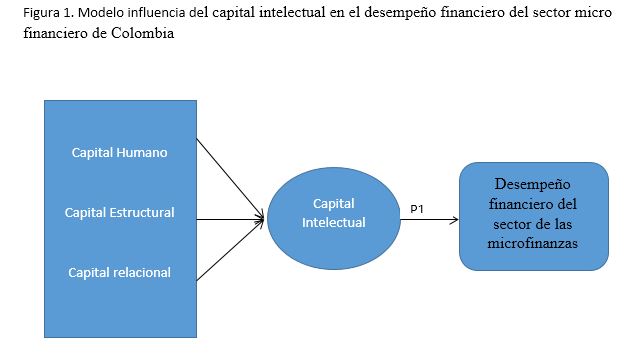
El capital intelectual fuente de la ventaja competitiva en las empresas de microcrédito en Colombia
Palabras clave
Referencias
Adongo, J., & Stork, C. (2005). Factors influencing the financial sustainability of selected microfinance institutions in Namibia. Namibian Economic Policy Research Unit.
Barney, J. (1991). Firm resources and sustained competitive advantage. Journal of management, 17(1), 99-120..
Becker, B., & Gerhart, B. (1996). The impact of human resource management on organizational performance: Progress and prospects. Academy of management journal, 39(4), 779-801..
Bontis, N. (1996). There's a price on your head: managing intellectual capital strategically. Business Quarterly, 60, 40-78.
Bontis, N. (1998). Intellectual capital: an exploratory study that develops measures and models. Management decision, 36(2), 63-76.
Cabrita, M. D. R., & Bontis, N. (2008). Intellectual capital and business performance in the Portuguese banking industry. International Journal of Technology Management, 43(1-3), 212-237.
Chen Goh, P. (2005). Intellectual capital performance of commercial banks in Malaysia. Journal of intellectual capital, 6(3), 385-396.
Choi, B., Poon, S. K., & Davis, J. G. (2008). Effects of knowledge management strategy on organizational performance: A complementarity theory-based approach. Omega, 36(2), 235-251.
Cohen, W. M., & Levinthal, D. A. (1990). Absorptive capacity: A new perspective on learning and innovation. Administrative science quarterly, 128-152..
Edvinsson, L., & Malone, M. S. (1997). Intellectual Capital: Realizing Your Company's True Value by Finding Its Hidden Brainpower. USA: Happer Collins, 1997.
Firer, S., & Mitchell Williams, S. (2003). Intellectual capital and traditional measures of corporate performance. Journal of intellectual capital, 4(3), 348-360.
García, E. Pelechano,J.E. Navas (2009) La complejidad del conocimiento frente a los medios de protección legal y su relación con el sostenimiento de las ventajas competitivas. Cuadernos de Economía y Dirección de la Empresa, 37 (2009), pp. 7-32
Goh, S., y Ryan P. J. (2002). «Learning capability, organizational factors and firm performance, learning and capabilities.» paper presented at the 3rd European Conference on organizational knowledge. Athens, 5-6 April 5-6., 2002.
Huang, H. C. (2009). Designing a knowledge-based system for strategic planning: A balanced scorecard perspective. Expert Systems with Applications, 36(1), 209-218.
Johnson, L. D., Neave, E. H., & Pazderka, B. (2002). Knowledge, innovation and share value. International Journal of Management Reviews, 4(2), 101-134.
Johnson, W. H. (1999). An integrative taxonomy of intellectual capital: measuring the stock and flow of intellectual capital components in the firm. International journal of technology management, 18(5-8), 562-575.
Johnson-Laird, P. N. (1983). Mental models: Towards a cognitive science of language, inference, and consciousness (No. 6). Harvard University Press.
Joia, L. A. (2000). Measuring intangible corporate assets: linking business strategy with intellectual capital. Journal of Intellectual capital, 1(1), 68-84.
OCDE (2005). «“Organización para la Cooperación y el Desarrollo Económico” (OCDE) en su “Manual de Oslo” del año.»
Peteraf, M. A. (1993). The cornerstones of competitive advantage: a resource‐based view. Strategic management journal, 14(3), 179-191..
Schultz, T. W. (1960). Capital formation by education. The journal of political economy, 571-583..
Stewart, T., & Ruckdeschel, C. (1998). Intellectual capital: The new wealth of organizations..
Van Buren, M. E. (1999). A yardstick for knowledge management. Training & development, 53(5), 71-78..
Verde, M. D., de Castro, G. M., López, J. E. N., & González, J. C. (2011). Capital social, capital relacional e innovación tecnológica: una aplicación al sector manufacturero español de alta y media-alta tecnología. Cudernos de Economía y Dirección de Empresas, 2011: 207-221.
Villalonga, B. (2004). Intangible resources, Tobin’s q, and sustainability of performance differences. Journal of Economic Behavior & Organization, 54(2), 205-230..
Wang, W. Y., & Chang, C. (2005). Intellectual capital and performance in causal models: Evidence from the information technology industry in Taiwan. Journal of intellectual capital, 6(2), 222-236..
Wu, S. H., Lin, L. Y., & Hsu, M. Y. (2007). Intellectual capital, dynamic capabilities and innovative performance of organisations. International Journal of Technology Management, 39(3-4), 279-296..
Zéghal, D., & Maaloul, A. (2010). Analysing value added as an indicator of intellectual capital and its consequences on company performance. Journal of Intellectual capital, 11(1), 39-60.
Enlaces refback
- No hay ningún enlace refback.





